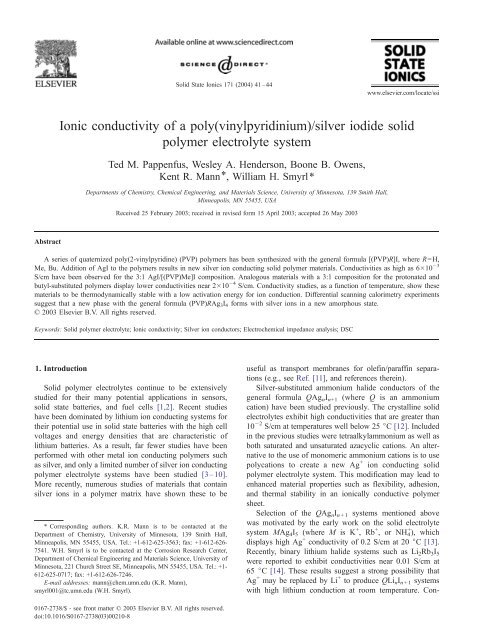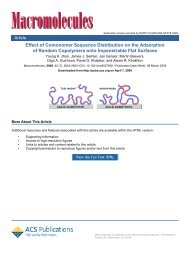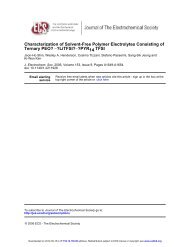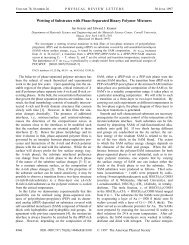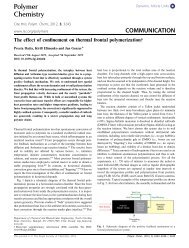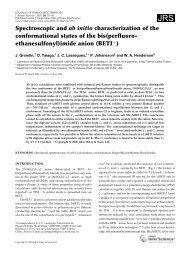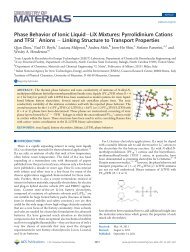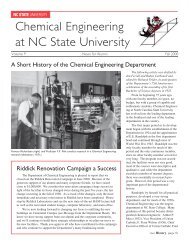Ionic conductivity of a poly(vinylpyridinium)/silver iodide solid ...
Ionic conductivity of a poly(vinylpyridinium)/silver iodide solid ...
Ionic conductivity of a poly(vinylpyridinium)/silver iodide solid ...
You also want an ePaper? Increase the reach of your titles
YUMPU automatically turns print PDFs into web optimized ePapers that Google loves.
Solid State <strong>Ionic</strong>s 171 (2004) 41–44www.elsevier.com/locate/ssi<strong>Ionic</strong> <strong>conductivity</strong> <strong>of</strong> a <strong>poly</strong>(<strong>vinylpyridinium</strong>)/<strong>silver</strong> <strong>iodide</strong> <strong>solid</strong><strong>poly</strong>mer electrolyte systemTed M. Pappenfus, Wesley A. Henderson, Boone B. Owens,Kent R. Mann*, William H. Smyrl*Departments <strong>of</strong> Chemistry, Chemical Engineering, and Materials Science, University <strong>of</strong> Minnesota, 139 Smith Hall,Minneapolis, MN 55455, USAReceived 25 February 2003; received in revised form 15 April 2003; accepted 26 May 2003AbstractA series <strong>of</strong> quaternized <strong>poly</strong>(2-vinylpyridine) (PVP) <strong>poly</strong>mers has been synthesized with the general formula [(PVP)R]I, where R=H,Me, Bu. Addition <strong>of</strong> AgI to the <strong>poly</strong>mers results in new <strong>silver</strong> ion conducting <strong>solid</strong> <strong>poly</strong>mer materials. Conductivities as high as 610 3S/cm have been observed for the 3:1 AgI/[(PVP)Me]I composition. Analogous materials with a 3:1 composition for the protonated andbutyl-substituted <strong>poly</strong>mers display lower conductivities near 210 4 S/cm. Conductivity studies, as a function <strong>of</strong> temperature, show thesematerials to be thermodynamically stable with a low activation energy for ion conduction. Differential scanning calorimetry experimentssuggest that a new phase with the general formula (PVP)RAg 3 I 4 forms with <strong>silver</strong> ions in a new amorphous state.D 2003 Elsevier B.V. All rights reserved.Keywords: Solid <strong>poly</strong>mer electrolyte; <strong>Ionic</strong> <strong>conductivity</strong>; Silver ion conductors; Electrochemical impedance analysis; DSC1. IntroductionSolid <strong>poly</strong>mer electrolytes continue to be extensivelystudied for their many potential applications in sensors,<strong>solid</strong> state batteries, and fuel cells [1,2]. Recent studieshave been dominated by lithium ion conducting systems fortheir potential use in <strong>solid</strong> state batteries with the high cellvoltages and energy densities that are characteristic <strong>of</strong>lithium batteries. As a result, far fewer studies have beenperformed with other metal ion conducting <strong>poly</strong>mers suchas <strong>silver</strong>, and only a limited number <strong>of</strong> <strong>silver</strong> ion conducting<strong>poly</strong>mer electrolyte systems have been studied [3–10].More recently, numerous studies <strong>of</strong> materials that contain<strong>silver</strong> ions in a <strong>poly</strong>mer matrix have shown these to be* Corresponding authors. K.R. Mann is to be contacted at theDepartment <strong>of</strong> Chemistry, University <strong>of</strong> Minnesota, 139 Smith Hall,Minneapolis, MN 55455, USA. Tel.: +1-612-625-3563; fax: +1-612-626-7541. W.H. Smyrl is to be contacted at the Corrosion Research Center,Department <strong>of</strong> Chemical Engineering and Materials Science, University <strong>of</strong>Minnesota, 221 Church Street SE, Minneapolis, MN 55455, USA. Tel.: +1-612-625-0717; fax: +1-612-626-7246.E-mail addresses: mann@chem.umn.edu (K.R. Mann),smyrl001@tc.umn.edu (W.H. Smyrl).useful as transport membranes for olefin/paraffin separations(e.g., see Ref. [11], and references therein).Silver-substituted ammonium halide conductors <strong>of</strong> thegeneral formula QAg n I n+1 (where Q is an ammoniumcation) have been studied previously. The crystalline <strong>solid</strong>electrolytes exhibit high conductivities that are greater than10 2 S/cm at temperatures well below 25 jC [12]. Includedin the previous studies were tetraalkylammonium as well asboth saturated and unsaturated azacyclic cations. An alternativeto the use <strong>of</strong> monomeric ammonium cations is to use<strong>poly</strong>cations to create a new Ag + ion conducting <strong>solid</strong><strong>poly</strong>mer electrolyte system. This modification may lead toenhanced material properties such as flexibility, adhesion,and thermal stability in an ionically conductive <strong>poly</strong>mersheet.Selection <strong>of</strong> the QAg n I n +1 systems mentioned abovewas motivated by the early work on the <strong>solid</strong> electrolytesystem MAg 4 I 5 (where M is K + , Rb + , or NH + 4 ), whichdisplays high Ag + <strong>conductivity</strong> <strong>of</strong> 0.2 S/cm at 20 jC [13].Recently, binary lithium halide systems such as Li 2 Rb 3 I 5were reported to exhibit conductivities near 0.01 S/cm at65 jC [14]. These results suggest a strong possibility thatAg + may be replaced by Li + to produce QLi n I n +1 systemswith high lithium conduction at room temperature. Con-0167-2738/$ - see front matter D 2003 Elsevier B.V. All rights reserved.doi:10.1016/S0167-2738(03)00210-8
42T.M. Pappenfus et al. / Solid State <strong>Ionic</strong>s 171 (2004) 41–44sequently, we initiated a two-phase strategy for the synthesis<strong>of</strong> conductive Li + <strong>solid</strong> <strong>poly</strong>mer electrolytes. Thefirst phase includes the preparation <strong>of</strong> highly conductiveAg + <strong>poly</strong>mer electrolytes. Once these materials are characterized,Ag + will be replaced with Li + to produce highlyconductive lithium <strong>solid</strong> <strong>poly</strong>mer electrolytes at ambienttemperature.During the first phase, we have prepared a series <strong>of</strong><strong>poly</strong>(<strong>vinylpyridinium</strong>) electrolytes <strong>of</strong> the general formula[(PVP)R]I, where R=H, Me, Bu (see Fig. 1). Upon addition<strong>of</strong> <strong>silver</strong> <strong>iodide</strong> to the <strong>poly</strong>electrolyte, increased ionic<strong>conductivity</strong> is obtained relative to pure <strong>silver</strong> <strong>iodide</strong>. Thispaper reports the results <strong>of</strong> the first phase studies: aninvestigation <strong>of</strong> the <strong>conductivity</strong> and thermal properties <strong>of</strong>the <strong>silver</strong> ion containing materials to gain insight intoproperty/composition relationships.2. Experimental2.1. Chemicals, reagents, and analysisReagent grade <strong>silver</strong> <strong>iodide</strong> (99.9%), 1-iodobutane,acetone, tetrahydr<strong>of</strong>uran (THF), and N,N V-dimethylformamide(DMF) were obtained from Aldrich and were usedas received. Hydriodic acid (HI) (57 wt.% aqueous solution)and iodomethane were obtained from Acros andwere used as received. A commercial grade <strong>of</strong> <strong>poly</strong>(2-vinylpyridine) (PVP), with a MW=387,000–520,000, wasutilized in the syntheses. Elemental analyses were performedby Quantitative Technologies (Whitehouse, NJ).Infrared spectra were obtained by the attenuated totalreflectance (ATR) method with a Nicolet Magna-FTIRSystem 550 spectrometer.2.2. Polymer synthesisAll reactions were performed under an argon atmosphereand were covered with foil to prevent exposure tolight. The [(PVP)Me]I and [(PVP)Bu]I compounds wereprepared by a method similar to a previously reportedprocedure [15]. The degree <strong>of</strong> quaternization was determinedby elemental analysis and confirmed by IR spectroscopyby comparison <strong>of</strong> the absorption peaks <strong>of</strong>‘‘unquaternized’’ PVP (1588 cm 1 ) and quaternized PVP(ca. 1610–1625 cm 1 ) [15].2.2.1. Synthesis <strong>of</strong> [(PVP)Me]IIn a typical reaction, 1 g <strong>of</strong> PVP was dissolved in 35 ml<strong>of</strong> DMF. Iodomethane (3 ml) was added, and the reactionwas stirred under argon for 48 h at 60 jC at which time alight-yellow precipitate formed. Acetone (60 ml) was addedto ensure complete precipitation. The precipitate was filteredand washed with acetone (510 ml) and diethyl ether(310 ml) to afford 2.2 g <strong>of</strong> [(PVP)Me]I as a light-yellow<strong>solid</strong>. The degree <strong>of</strong> quaternization was approximately 98%<strong>of</strong> the pyridine monomeric units. Larger-scale reactions (f4g <strong>of</strong> PVP) resulted in approximately 88% quaternization <strong>of</strong>the pyridine rings under identical conditions. IR (ATR) 1625(vs), 1577 (m), 1510 (s), 1457 (s), 1435 (m) cm 1 .2.2.2. Synthesis <strong>of</strong> [(PVP)Bu]IPVP (4 g) and 21.7 ml <strong>of</strong> 1-iodobutane in 225 ml <strong>of</strong>DMF were stirred at 110 jC for 48 h. The reaction mixturewas poured into 500 ml <strong>of</strong> acetone, which resulted in ayellow precipitate. The <strong>solid</strong> was filtered and washed withacetone (420 ml) to afford 8.8 g <strong>of</strong> [(PVP)Bu]I as a lightyellow<strong>solid</strong>. The degree <strong>of</strong> quaternization was determinedto be approximately 80%. IR (ATR) 1624 (vs), 1610 (s),1576 (w), 1510 (w), 1465 (m) cm 1 .2.2.3. Synthesis <strong>of</strong> [(PVP)H]IPVP (1 g) was dissolved in 30 ml <strong>of</strong> THF. Hydroiodicacid (3 ml) was added dropwise with stirring at which timean immediate precipitate formed. The reaction mixture wasstirred for an additional 5 min, and the <strong>solid</strong> was filtered andwashed with acetone (525 ml) to afford 2.2 g <strong>of</strong>[(PVP)H]I. The degree <strong>of</strong> quaternization <strong>of</strong> the <strong>poly</strong>mer,analyzed as a monohydrate, is 100%. IR (ATR) 1610 (vs),1535 (m), 1464 (m) cm 1 .2.3. Addition <strong>of</strong> <strong>silver</strong> <strong>iodide</strong> to <strong>poly</strong>electrolytesAll sample preparation steps and storage <strong>of</strong> the materialswere conducted in a dry room (
2.5. Differential scanning calorimetryDSC measurements were performed using a liquid-nitrogen-cooledPerkin-Elmer Pyris 1 Differential ScanningCalorimeter. Small amounts <strong>of</strong> the samples (8–25 mg) wereadded to aluminum pans that were then crimped sealed.Typically, the sample pans were slowly heated from ambienttemperature at 10 jC/min. The background has been subtractedfrom the reported DSC traces.T.M. Pappenfus et al. / Solid State <strong>Ionic</strong>s 171 (2004) 41–44 433. Results and discussion3.1. <strong>Ionic</strong> <strong>conductivity</strong>Fig. 3. Arrhenius plots <strong>of</strong> the ionic <strong>conductivity</strong> (26–100 jC) <strong>of</strong> the[(PVP)R]I–AgI systems: (5) R=H, (n) R =Me, and () R=Bu.The pure <strong>poly</strong>mer electrolytes synthesized here([(PVP)R]I, where R=H, Me, Bu) do not display measurableconductivities (
44T.M. Pappenfus et al. / Solid State <strong>Ionic</strong>s 171 (2004) 41–44ever, <strong>of</strong> both the (PVP)HAg 3 I 4 and (PVP)BuAg 3 I 4 materialswere more than an order <strong>of</strong> magnitude lower in<strong>conductivity</strong> with nearly identical values <strong>of</strong> 210 4 S/cm.Some <strong>of</strong> the samples at a given composition for thematerials <strong>of</strong> all three <strong>poly</strong>mers did not yield consistentlyhigh conductivities. This may be attributed to incompletereaction <strong>of</strong> the <strong>solid</strong> state reactants.The temperature dependence <strong>of</strong> the <strong>conductivity</strong> <strong>of</strong> thenew materials is shown in Fig. 3 for the temperature range<strong>of</strong> 26–100 jC. The <strong>conductivity</strong> increases slowly withincreasing temperature, as expected for a <strong>solid</strong> electrolytematerial with a low activation energy for conduction. Theapparent activation energies for the methyl and protonatedsystems are 0.16 and 0.19 eV, respectively, and are inexcellent agreement with previously reported <strong>silver</strong> ion<strong>poly</strong>mer electrolytes [9]. The activation energy for thebutyl-substituted material was not calculated, but it isanticipated to be similar to the other two materials, basedon the slope <strong>of</strong> the data presented. No thermal transitionsover this temperature range are evident, suggesting that theconducting phase is thermodynamically stable in thisrange.3.2. Differential scanning calorimetryDSC results for the (PVP)MeAg n I n+1 system are shownin Fig. 4. Silver <strong>iodide</strong> has a well known h–a transformationtemperature near 148 jC that is clearly displayed inthe DSC plot for pure AgI (Fig. 4, top). This is theendothermic transition from the low <strong>conductivity</strong> phaseto the highly conducting phase that exists above 148 jC.The binary mixtures corresponding to 4 or 5 mol AgI/mol<strong>poly</strong>mer unit also exhibit this <strong>solid</strong>–<strong>solid</strong> AgI transition,but with smaller specific heats. At or below the composition<strong>of</strong> 3 AgI units/<strong>poly</strong>mer unit (75 mol% AgI), little orno thermal evidence <strong>of</strong> crystalline AgI is detected in thesamples. [(PVP)Me]I with no added <strong>silver</strong> <strong>iodide</strong> shows aglass transition temperature (T g ) near 175 jC, well abovethe T g for the non-quaternized PVP, which has a T g near100 jC [17]. Furthermore, the T g <strong>of</strong> the <strong>poly</strong>mer decreaseswith increasing <strong>silver</strong> <strong>iodide</strong> content. These data areconsistent with the formation <strong>of</strong> a new discrete material<strong>of</strong> the composition (PVP)MeAg 3 I 4 .Monomeric systems, such as the pyridinium <strong>iodide</strong>–<strong>silver</strong> <strong>iodide</strong> system, form highly crystalline <strong>solid</strong> electrolytes.For example, the PyI–AgI system (where Py ispyridinium) form crystalline materials with compositions<strong>of</strong> PyAg 5 I 6 and Py 5 Ag 18 I 23 [18]. In these structures, the<strong>iodide</strong> ions form face-sharing tetrahedra, which are thesuggested pathways for <strong>silver</strong> ion conduction. Althoughour materials appear to be amorphous, they may have asimilar short range order that accounts for the high<strong>conductivity</strong>.4. ConclusionSilver <strong>iodide</strong> forms new <strong>solid</strong> state materials withquaternized <strong>poly</strong>(2-vinylpyridine) <strong>poly</strong>mers <strong>of</strong> the generalformula [(PVP)R]I. The maximum room temperature <strong>conductivity</strong>has been found to be 610 3 S/cm for theaddition <strong>of</strong> three equivalents <strong>of</strong> <strong>silver</strong> <strong>iodide</strong> to themethylated <strong>poly</strong>mer. The protonated and butyl-substituted<strong>poly</strong>mers exhibit enhanced <strong>conductivity</strong>, but they are bothmore than an order <strong>of</strong> magnitude lower in <strong>conductivity</strong>than the methylated analog. DSC data, coupled with the<strong>conductivity</strong> data, suggest the formation <strong>of</strong> new discretematerials <strong>of</strong> the general formula (PVP)RAg 3 I 4 . Thesematerials represent a new class <strong>of</strong> ion conducting <strong>solid</strong><strong>poly</strong>mer electrolytes.AcknowledgementsThis research was supported by NASA ResearchProgram NRA-00-GRC-1.References[1] B. Scrosati (Ed.), Application <strong>of</strong> Electroactive Polymers, Chapman &Hall, London, 1993.[2] F.M. Gray, Solid Polymer Electrolytes: Fundamentals and TechnologicalApplications, VCH, New York, 1991.[3] H. Eliasson, I. Albinsson, B.-E. Mellander, Electrochim. Acta 43(1998) 1459–1463.[4] S.S. Rao, K.V.S. Rao, Md. Shareefuddin, U.V.S. Rao, S. Chandra,Solid State <strong>Ionic</strong>s 67 (1994) 331–334.[5] S. Chandra, S.A. Hashmi, M. Saleem, R.C. Agrawal, Solid State<strong>Ionic</strong>s 67 (1993) 1 –7.[6] M.L. Kaplan, E.A. Reitman, R.J. Cava, Polymer 30 (1989) 504–508.[7] P. Fabry, C. Montero-Ocampo, M. Armand, Sens. Actuators 15(1988) 1 –9.[8] T.M.A. Abrantes, L.J. Alcacer, C.A.C. Sequeira, Solid State <strong>Ionic</strong>s18–19 (1986) 315–320.[9] J.R. Stevens, B.-E. Mellander, Solid State <strong>Ionic</strong>s 21 (1986) 203–206.[10] S. Clancy, D.F. Shriver, L.A. Ochrymowycz, Macromolecules 19(1986) 606–611.[11] J.H. Kim, B.R. Min, C.K. Kim, J. Won, Y.S. Kang, Macromolecules35 (2002) 5250–5255.[12] B.B. Owens, C.W. Tobias (Eds.), Solid Electrolyte Batteries, Advancesin Electrochemistry and Electrochemical Engineering, vol. 8,Wiley-Interscience, New York, 1971, Chap. 1.[13] B.B. Owens, G.R. Argue, Science 157 (1967) 308–310.[14] X. Wei, D.F. Shriver, Chem. Mater. 12 (2000) 2528–2529.[15] M. Beer, M. Schmidt, M. Muthukumar, Macromolecules 30 (1997)8375–8385.[16] S.A. Hashmi, A. Chandra, S. Chandra, in: B.V.R. Chowdari (Ed.),Solid State <strong>Ionic</strong>s: Materials and Applications, World Scientific, Singapore,1992, pp. 567–571.[17] R. Grooten, G. Brinke, Macromolecules 22 (1989) 1761–1766.[18] S. Geller, Topics in Applied Physics, Solid Electrolytes, Springer-Verlag, New York, 1977.


